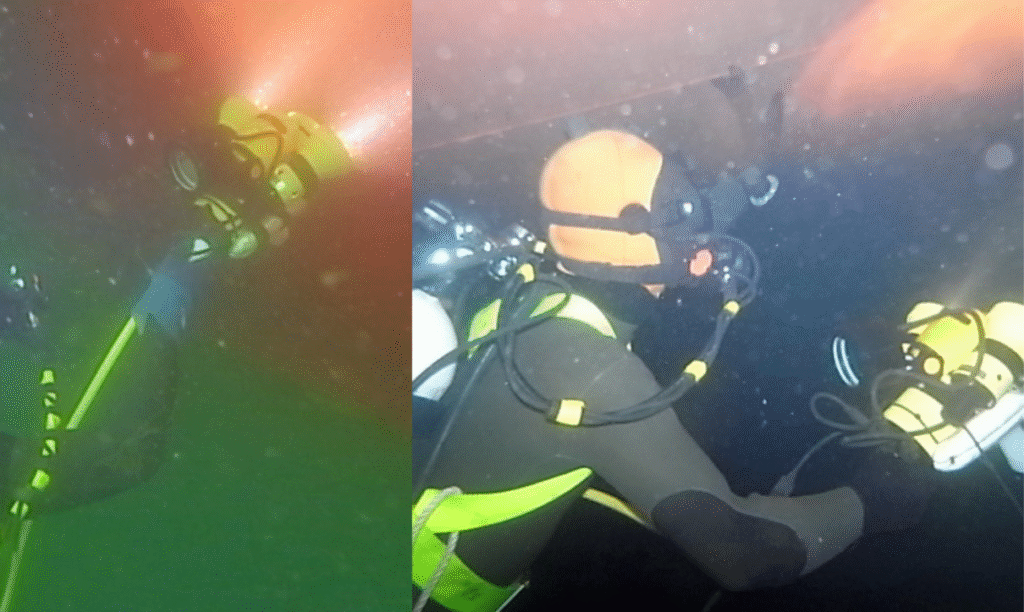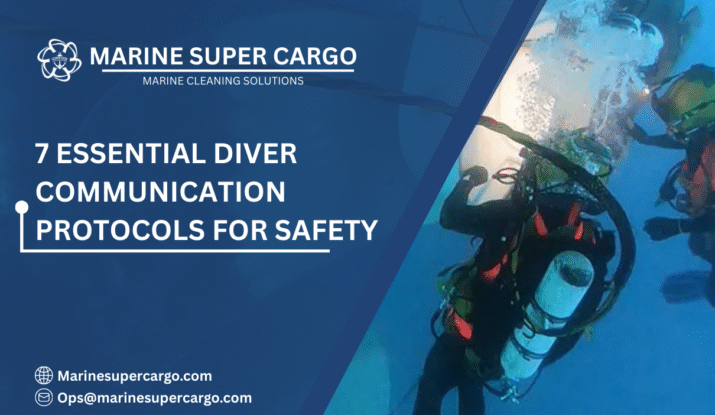Imagine working in a place where sound is muffled, vision is blurred, and every action depends on clarity and trust. That’s the underwater environment. In this world, diver communication protocols aren’t just convenient—they are the lifeline connecting divers to the surface crew.
In underwater cleaning, hull inspections, or repairs, miscommunication isn’t a small error—it can mean the difference between a successful operation and a tragedy. In this article, we’ll unpack the essentials of communication between divers and crew, highlighting best practices, compliance standards, and real-world applications for ship owners and operators.
Why Diver Communication Protocols Matter
Diving operations are high-risk, and effective communication keeps risks manageable. Divers must signal needs quickly, surface crews must understand instantly, and both sides must trust the system. Solid diver communication protocols:
- Prevent accidents caused by delays or misunderstandings.
- Build trust between divers and supervisors.
- Ensure compliance with IMCA guidelines and IMO safety codes.
- Minimize downtime and operation costs.
- Protect both human life and vessel integrity.
Think of these protocols as a ship’s compass: without them, divers would be wandering blind beneath the waves.

The Fundamentals of Diver Communication
At its core, communication bridges the unknown world below with the command center above. Core forms include:
- Wired Voice Communications: Helmet or mask wired directly to the surface for two-way speaking.
- Wireless Systems: Useful in certain operations but prone to interference.
- Hand Signals: Essential redundancy when systems fail.
- Line Pull Signals: A series of tugs on the dive umbilical to convey specific instructions.
- Written Slates: Used when detail is needed in emergencies or training.
Each diver must master multiple modes. Redundancy is protection. Also read about underwater hull cleaning in Australia.
Standard Diver Communication Protocols
International bodies such as IMCA (imca-int.com) have set tried-and-true standards. Common diver communication protocols include:
- One Pull: “Are you okay?” / “I am okay”.
- Two Pulls: “Lower me down” or descent needed.
- Three Pulls: “Take me up” or “I’m ascending”.
- Four Pulls: Emergency – pull me up immediately.
- Hand Across Throat: “Stop” or “Danger”.
- Thumbs Up: Surface or abort dive.
- Writing Slate: Used to communicate details like equipment faults.
By combining simplicity with universality, these signals leave little room for confusion.
🌊✨ Client Testimonial Spotlight ✨🌊
— Marine Super Cargo (@Marinsupercargo) September 16, 2025
💬 “The team at Marine Super Cargo feels like part of our crew. From hold cleaning to supercargo support, they handle everything seamlessly. Their quick response and reliable service saved us valuable time and money.” – Mr. Ingmar Domrös pic.twitter.com/bPlooKOakt
Communication Protocols During Underwater Cleaning
Hull cleaning adds its own hazards: biofouling entanglement, low visibility, and hazardous discharges. Special diver communication protocols in cleaning include:
- Constant line checks to confirm the diver’s location.
- Surface vocal confirmations when changing cleaning equipment.
- Pre-agreed emergency code words or signals for entanglement near propellers.
- Environmental alerts if pollution like oil sheens is noticed beneath the vessel (critical under MARPOL Convention).
Clarity allows workers to operate confidently even in dirty, confined conditions.
Crew’s Role in Diver Communication
The surface crew aren’t passive listeners—they are active guardians. In fact, effective diver communication protocols rely equally on the discipline of those topside.
Key duties include:
- Maintaining constant verbal check-ins.
- Logging diver messages in real-time.
- Updating the diving supervisor of any abnormalities immediately.
- Notifying vessel masters if machinery, thrusters, or discharges are detected.
Every diver trusts their life to a vigilant crew.
Compliance and Legal Frameworks
Why emphasize communication so much? Because regulators demand it. Robust diver communication protocols are mandated by:
- IMCA Guidelines recommending redundancy of systems.
- International Maritime Organization (IMO) conventions on safe diving and crew coordination.
- MARPOL measures ensure divers can report marine pollution risks mid-job.
- IAPH port guidelines require standardized communications for port safety.
Clear communication is proof of due diligence in case of audits or investigations. It protects lives and legal standing.
Real Example: Communication Saves a Life
During an underwater hull cleaning at a busy port, a diver’s umbilical fouled on marine growth. His voice communication crackled, then cut. But the crew noticed irregular line tension and applied the emergency diver communication protocols—four strong tugs. The diver confirmed distress with hand signals, and the standby diver rushed in. Within minutes, he was freed.
Without those pre-agreed protocols, hesitation might have cost his life.
Innovations in Diver Communication
The future of diver-surface communication is more advanced than ever:
- Digital Voice Enhancements: Noise cancellation and clarity through advanced helmets.
- Hands-Free Wireless Tech: Less reliance on umbilicals, though needing reliability fixes.
- Biometric Streaming: Surface teams monitor divers’ vitals alongside their words.
- ROV-linked cameras: Surface crews see exactly what the diver sees.
- AI-assisted Alerts: Systems that detect silence or irregular speech tone as distress signs.
But even with advanced tech, basic diver communication protocols like line signals will always remain vital backups.

Practical Tips for Ship Owners and Managers
You don’t need cutting-edge tech to get communication right. Practical improvements you can apply include:
- Standardize training across all divers on IMCA-approved signals.
- Regularly drill emergencies where comms are cut unexpectedly.
- Maintain redundant systems: wired, visual, and physical signals.
- Test equipment before every dive and log checks.
- Encourage crews to speak up if misunderstandings happen—better to stop than misinterpret.
In safety, repetition isn’t boring; it’s life-saving.
Conclusion
In diving operations, communication is everything. Strong diver communication protocols create a lifeline between divers and surface teams. Remember:
- Redundancy in communication prevents catastrophe when systems fail.
- Crew vigilance is as crucial as diver awareness.
- Compliance with IMO, IMCA, and MARPOL standards ensures both safety and trust.
For operators seeking reliable, sustainable safety in diving and hull cleaning, turn to trusted partners like CleanShip.co—pioneers in compliance and operational excellence.
FAQs:
Q1. Why are diver communication protocols so important?
They prevent misunderstandings, minimize accidents, and ensure divers can request help instantly when underwater challenges arise.
Q2. What are the most common communication methods with divers?
Voice systems, rope signals, hand gestures, and slates are standard, with multiple redundancies used in every dive.
Q3. Who is responsible for maintaining safe communication underwater?
The diving supervisor oversees, but both divers and surface crew share responsibility for clarity and consistency.
Q4. How does communication tie into environmental safety?
Divers must report discharges like oil or waste, ensuring compliance with the MARPOL Convention during maintenance or cleaning.
Q5. Will technology make divers fully independent of protocols?
No—while helmets and AI assist, basic diver communication protocols like rope pulls ensure survival when tech fails.


